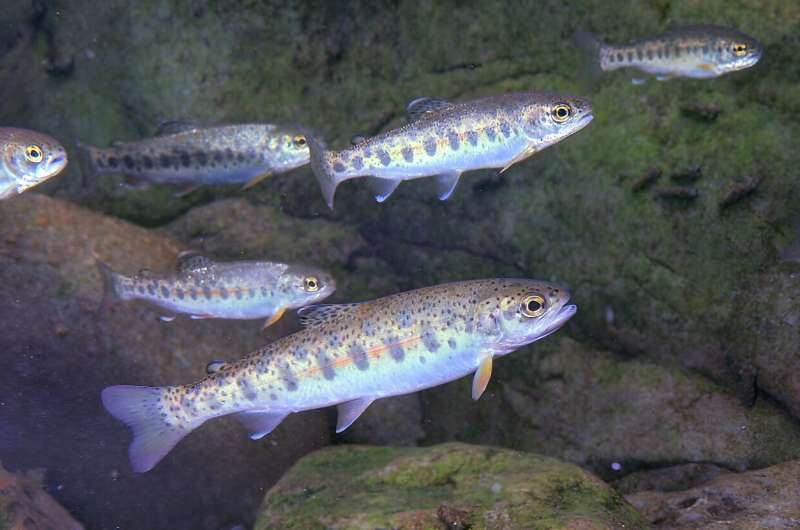This article has been reviewed according to Science X's editorial process and policies. Editors have highlighted the following attributes while ensuring the content's credibility:
fact-checked
peer-reviewed publication
trusted source
proofread
Billions in conservation spending fail to improve wild fish stocks in Columbia Basin

Four decades of conservation spending totaling more than $9 billion in inflation-adjusted tax dollars has failed to improve stocks of wild salmon and steelhead in the Columbia River Basin, according to Oregon State University research.
The study led by William Jaeger of the OSU College of Agricultural Sciences is based on an analysis of 50 years of data suggesting that while hatchery-reared salmon numbers have increased, there is no evidence of a net increase in wild, naturally spawning salmon and steelhead.
The findings were published today in PLOS One.
Jaeger, a professor of applied economics, notes that steelhead and Chinook, coho and sockeye salmon numbers have been under heavy pressure in the Columbia River Basin for more than a century and a half—initially from overharvesting, then from hydropower beginning in 1938 with the opening of Bonneville Dam, the lowermost dam on the mainstem Columbia.
"Also, farming, logging, mining and irrigation caused landscape changes and habitat degradation, which compounded the problems for the fish," said Jaeger, who collaborated on the paper with Mark Scheuerell, a biologist with the U.S. Geological Survey and the University of Washington.
An estimated 16 million salmon and steelhead once returned from the Pacific to the portions of the basin above Bonneville Dam, but by the 1970s there were fewer than 1 million fish, prompting the federal government to intervene.
The Northwest Power Act of 1980 required fish and wildlife goals to be considered in addition to power generation and other objectives. The act created the Northwest Power and Conservation Council to set up conservation programs financed by Bonneville Power Administration revenues.
The cost and scale of restoration efforts grew considerably in the 1990s, Jaeger said, following the listing of 12 Columbia River runs of salmon and steelhead as threatened or endangered under the Endangered Species Act.
The public's tab for conservation spending now exceeds $9 billion in inflation-adjusted 2020 U.S. dollars, the researchers said, which does not take into account all monies that have been spent by local governments and non-governmental agencies.
"The actual impact of all of these efforts has always been poorly understood," Jaeger said. "Lots of people have long been concerned about a lack of evidence of salmon and steelhead recovery. One of the issues is that most studies evaluating restoration efforts have examined individual projects for specific species, life stages or geographic areas, which limits the ability to make broad inferences at the basin level."
Thus, Jaeger notes, a key question has persisted, and its answer is critical for sound policy and legal decisions: Is there any evidence of an overall boost in wild fish abundance that can be linked to the totality of the recovery efforts?
Based on a half-century of fish return data at Bonneville Dam, the single entry point to the basin above the dam, the evidence does not support a yes answer.
"We found no evidence in the data that the restoration spending is associated with a net increase in wild fish abundance," Jaeger said.
He said the Northwest Power and Conservation Council set a goal of increasing total salmon and steelhead abundance in the basin to 5 million fish by 2025, but annual adult returns at Bonneville Dam averaged less than 1.5 million in the 2010s.
And while hatchery production has helped with overall numbers of adult fish, Jaeger added, it has also adversely affected wild stocks through a range of mechanisms including genetics, disease, competition for habitat and food, and predation on wild fish by hatchery fish.
"The role of hatcheries in recovery plans is controversial for many reasons, but results do indicate that hatchery production combined with restoration spending is associated with increases in returning adult fish," Jaeger said. "However, we found that adult returns attributable to spending and hatchery releases combined do not exceed what we can attribute to hatcheries alone. We looked at ocean conditions and other environmental variables, hatchery releases, survival rates for hatchery released fish, and conservation spending, and we saw no indication of a positive net effect for wild fish."
Even expenditures on "durable" habitat improvements designed to cumulatively benefit naturally spawning wild salmon and steelhead over many years did not lead to evidence of a return on these investments, he added.
More information: William K. Jaeger et al, Return(s) on investment: Restoration spending in the Columbia River Basin and increased abundance of salmon and steelhead, PLOS ONE (2023). DOI: 10.1371/journal.pone.0289246
Journal information: PLoS ONE
Provided by Oregon State University



















